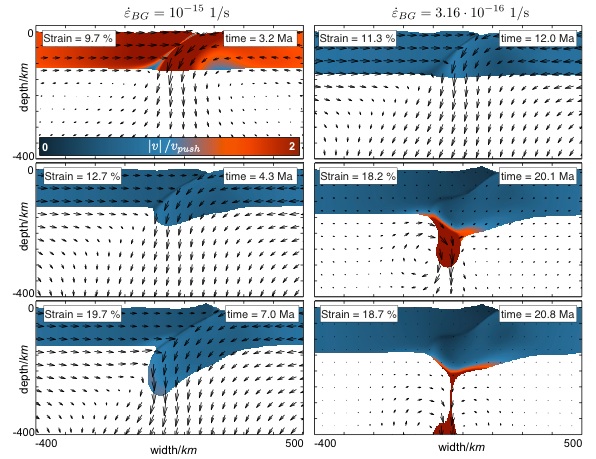My research

IMPACT OF SHEAR HEATING ON LITHOSPHERIC DEFORMATION
The theory of plate tectonics is a well established model that allows us to describe a multitude of phenomena that we observe on Earth (mid oceanic ridges, subduction zones, mountain belts etc.). However, it is still not completetly understood why and how plate tectonics started on Earth. This question is somewhat important as plate tectonics is thought to be an important ingredient in the formation process of a habitable climate. In our solar system, Earth is the only planet which exhibits plate tectonics. It is therefore important to understand subduction initiation (the starting point for plate tectonics).
I use both numerical models as well as scaling analyses to investigate the role of different weakening mechanisms on deformation in the lithosphere. The main focus lies on shear heating as a potential candidate. Shear heating (also called viscous dissipation) converts deformational work to heat. In traditional mantle convection models, this term is usually neglected, as it is very small at mantle conditions. However, as stresses in the lithosphere are significantly higher than in the Earth’s mantle, this effect gains in importance. We could show that shear heating is indeed capable of creating a lithospheric-scale shear zone, which enables subduction to initiate.

Comparison between three simulations with no shear heating, 50% shear heating efficiency and 100% shear heating efficiency. Colors correspond to the second invariant of strain rate, grey shades to the rock type, with selected isotherms plotted as white lines. One can clearly see that the shear heating efficiency affects the formation of a lithospheric-scale shear zone.
Furthermore, we could show that after the formation of a stable lithospheric-scale shear zone, the process of subduction initiation might be severely affected by convective instabilities which remove the slab tip of the downgoing plate.





Comparison between two simulations that differ only in the amount of the prescribed background strain rate. Colors denote the ratio between the actual velocity and the pushing velocity. It is evident that the left simulation shows a “proper” subduction initiating, whereas the right simulation shows a “tip-drip”.


As a last step, we used semi-analytical scaling laws to describe both processes and thus were able to predict the behaviour observed in the 2D models using 1D models. By doing this, we found out that the length scale that controls the fast formation of a lithospheric-scale shear zone is a quarter of the dominant folding wavelength. More details can be found here.

Movie of a simulation where a lithospheric-scale shear zone is created by shear heating which then subsequently evolves into a subduction zone.

THE INTERPLAY BETWEEN GRAIN SIZE EVOLUTION AND SHEAR HEATING
Although shear heating seems to be an important ingredient in the localization of deformation in the lithosphere, evidence of shear heating in ductile shear zones is scarce. On the other hand, most ductile shear zones are characterized by small grain sizes. This is why grain size reduction is oftentimes thought to be the governing mechanism which localizes deformation. We therefore investigate the interplay between both weakening mechanisms using 1D simple shear models.
Movie of a 1D simple shear simulation with grain size evolution and shear heating.
The top row shows the evolution of stress vs. the logarithm of time, the smaller plots in the bottom row show a cross section between -5 and 5 km at the respective time. The left plot shows temperature in K, the middle plot the logarithm of grain size (m) and the right plot the logarithm of the ratio between the diffusion and dislocation creep strain rate. If this values goes above 1 (the grey area), deformation is dominated by diffusion creep.


When both weakening mechanisms are combined (and for a certain range of parameters), we observe that deformation is localized because of shear heating, but that grain size reduction then keeps the shear zone weak and even deforms in diffusion creep. This is in agreement with field observations.